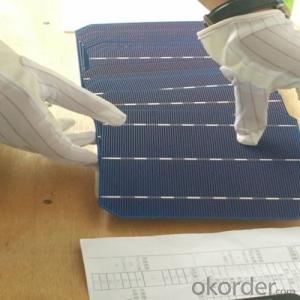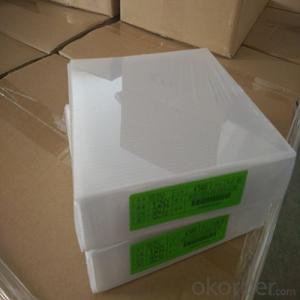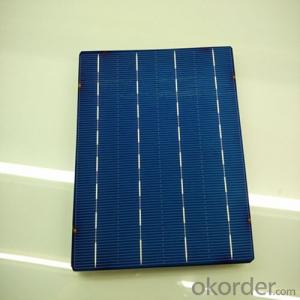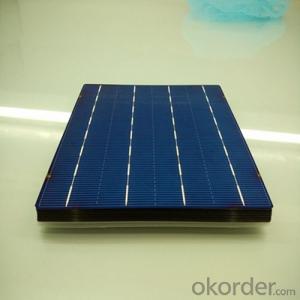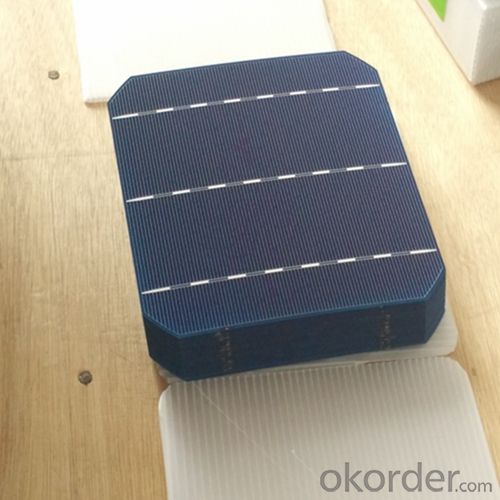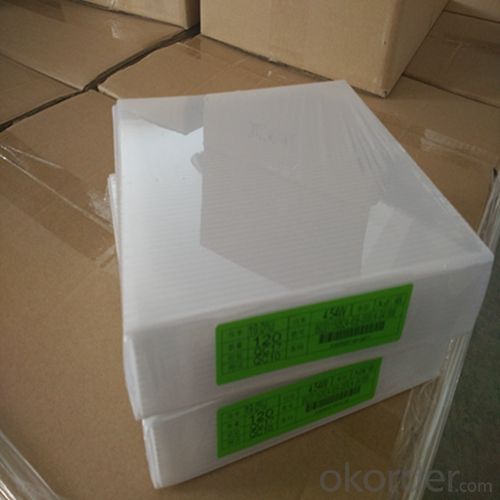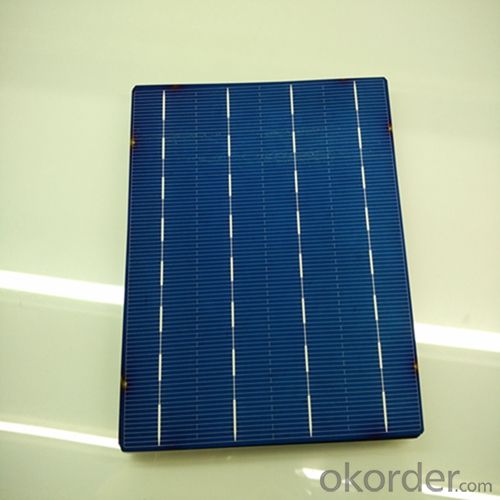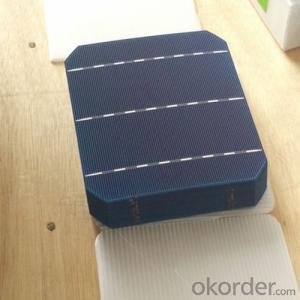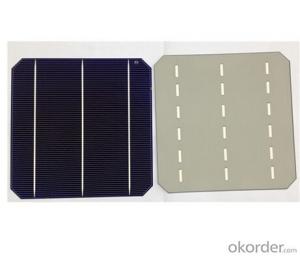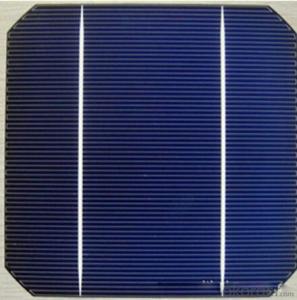Silicon Based Solar Cells - Mono 156x156mm2 Solar Cells Made in China
- Loading Port:
- Shanghai
- Payment Terms:
- TT OR LC
- Min Order Qty:
- 6000 watt
- Supply Capability:
- 6000000 watt/month
OKorder Service Pledge
OKorder Financial Service
You Might Also Like
The operation of a photovoltaic (PV) cell requires 3 basic attributes:
The absorption of light, generating either electron-hole pairs or excitons.
The separation of charge carriers of opposite types.
The separate extraction of those carriers to an external circuit.
In contrast, a solar thermal collector supplies heat by absorbing sunlight, for the purpose of either direct heating or indirect electrical power generation from heat. A "photoelectrolytic cell" (photoelectrochemical cell), on the other hand, refers either to a type of photovoltaic cell (like that developed by Edmond Becquerel and modern dye-sensitized solar cells), or to a device that splits water directly into hydrogen and oxygen using only solar illumination.Characteristic of Mono 156X156MM2 Solar Cells
You are gaining energy independence - add battery backup power for even greater energy security
The cost of electricity is only going to rise – insure against that rising cost
Adaptive cells change their absorption/reflection characteristics depending to respond to environmental conditions. An adaptive material responds to the intensity and angle of incident light. At the part of the cell where the light is most intense, the cell surface changes from reflective to adaptive, allowing the light to penetrate the cell. The other parts of the cell remain reflective increasing the retention of the absorbed light within the cell.[67]
In 2014 a system that combined an adaptive surface with a glass substrate that redirect the absorbed to a light absorber on the edges of the sheet. The system also included an array of fixed lenses/mirrors to concentrate light onto the adaptive surface. As the day continues, the concentrated light moves along the surface of the cell. That surface switches from reflective to adaptive when the light is most concentrated and back to reflective after the light moves along
Mechanical data and design
Format | 156mm x 156mm±0.5mm |
Thickness | 210μm±40μm |
Front(-) | 1.5mm bus bar (silver),blue anti-reflection coating (silicon nitride) |
Back (+) | 2.5mm wide soldering pads (sliver) back surface field (aluminium) |
Temperature Coefficient of Cells
Voc. Temp.coef.%/K | -0.35% |
Isc. Temp.coef .%/K | +0.024%/K |
Pm.Temp.coef. %/K | -0.47%/K |
Electrical Characteristic
Effiency(%) | Pmpp(W) | Umpp(V) | Impp(A) | Uoc(V) | Isc(A) | FF(%) |
18.35 | 4.384 | 0.526 | 8.333 | 0.63 | 8.877 | 78.39% |
18.20 | 4.349 | 0.526 | 8.263 | 0.63 | 8.789 | 78.54% |
18.05 | 4.313 | 0.525 | 8.216 | 0.63 | 8.741 | 78.32% |
17.90 | 4.277 | 0.524 | 8.161 | 0.625 | 8.713 | 78.04% |
17.75 | 4.241 | 0.523 | 8.116 | 0.625 | 8.678 | 77.70% |
17.60 | 4.206 | 0.521 | 8.073 | 0.625 | 8.657 | 77.36% |
17.45 | 4.170 | 0.519 | 8.039 | 0.625 | 8.633 | 76.92% |
17.30 | 4.134 | 0.517 | 8.004 | 0.625 | 8.622 | 76.59% |
17.15 | 4.096 | 0.516 | 7.938 | 0.625 | 8.537 | 76.80% |
17.00 | 4.062 | 0.512 | 7.933 | 0.625 | 8.531 | 76.18% |
16.75 | 4.002 | 0.511 | 7.828 | 0.625 | 8.499 | 75.34% |
16.50 | 3.940 | 0.510 | 7.731 | 0.625 | 8.484 | 74.36% |
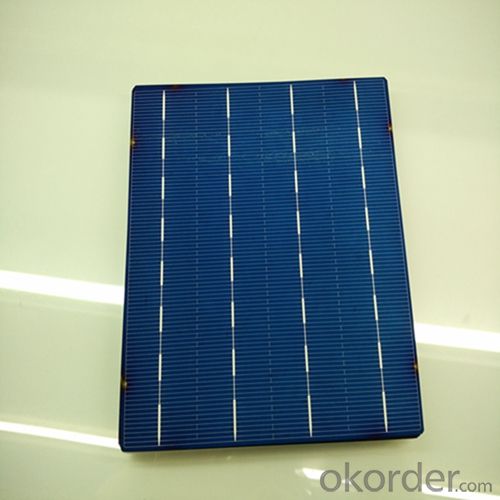
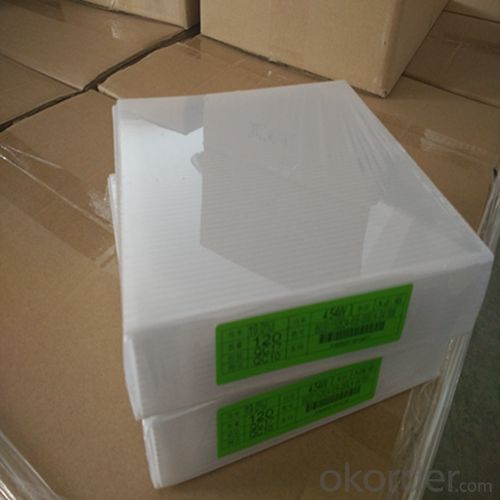
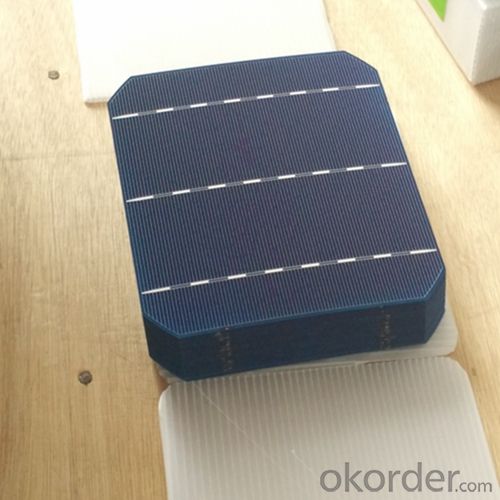
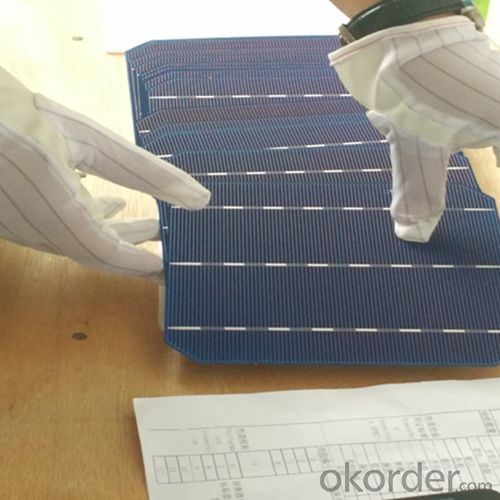
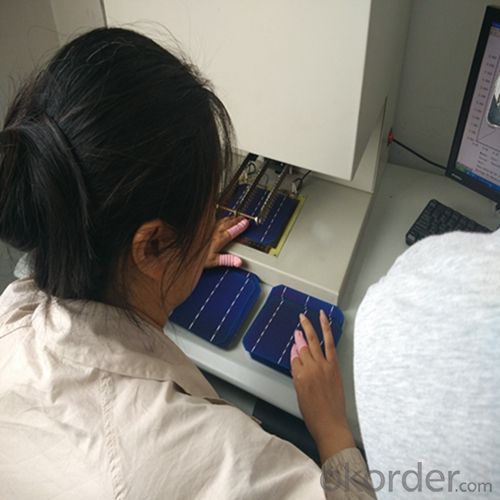 FAQ
FAQ
Q: What price for each watt?
A: It depends on the quantity, delivery date and payment terms, generally Large Quantity and Low Price
Q: What is your size for each module? Can you tell me the Parameter of your module?
A: We have different series of panels in different output, both c-Si and a-Si. Please take the specification sheet for your reference.
Q: What is your size for each module? Can you tell me the Parameter of your module?
A: We have different series of panels in different output, both c-Si and a-Si. Please take the specification sheet for your reference.
- Q: Can I buy solar cells easily online?
- I don't know about solar cells, but I do know you can buy solar panels online.
- Q: Can solar cells be used in military vehicles?
- Yes, solar cells can be used in military vehicles. They can provide an alternative source of energy to power various systems and equipment, reducing reliance on traditional fuel sources and enabling greater operational flexibility and sustainability. Additionally, solar cells can help extend the range and endurance of military vehicles in remote or austere environments where access to conventional fuel supplies may be limited.
- Q: How do solar cells perform in different geographical locations?
- Solar cells perform differently in different geographical locations due to variations in sunlight intensity and weather conditions. Generally, locations closer to the equator receive more sunlight and have higher solar energy potential, resulting in better solar cell performance. However, solar cells can still generate electricity in less sunny areas, albeit with reduced efficiency. Factors such as cloud cover, temperature, and air pollution can also affect their performance. Therefore, it is important to consider the specific geographical location and its unique characteristics when assessing the performance of solar cells.
- Q: What is the role of solar cells in powering agricultural irrigation?
- The role of solar cells in powering agricultural irrigation is to harness the energy from the sun and convert it into electricity, which can then be used to power irrigation systems. By using solar cells, farmers can reduce their reliance on fossil fuels and decrease their carbon footprint, while also ensuring a consistent and sustainable source of power for their irrigation needs. This renewable energy source helps to make agricultural irrigation more efficient, cost-effective, and environmentally friendly.
- Q: Can solar cells be installed on any type of roof?
- Solar cells can be installed on most types of roofs, including flat, sloped, and even curved roofs. However, the feasibility and efficiency of installation may vary depending on factors such as roof orientation, shading, structural integrity, and local regulations. It is advisable to consult with a professional solar installer to determine the suitability of your specific roof for solar panel installation.
- Q: Can solar cells be combined with energy storage systems?
- Yes, solar cells can be combined with energy storage systems. This combination allows for the capture and storage of excess solar energy generated during periods of high sunlight, which can then be used during times when solar energy is not available. Energy storage systems help address the intermittent nature of solar power, ensuring a continuous and reliable energy supply.
- Q: How do solar cells impact local economies?
- Solar cells can have a positive impact on local economies by creating jobs in the renewable energy sector, attracting investments, and reducing energy costs for businesses and households. Additionally, the deployment of solar cells can stimulate economic growth through increased demand for related goods and services, ultimately contributing to the development of sustainable and resilient local economies.
- Q: Why should the solar cells be laserized?
- Compared to the mechanical scribing in terms of slag will not cause short circuit, laser scribing is non-contact processing way, will not cause damage to the substrate.
- Q: Can solar cells be used to power water pumps or irrigation systems?
- Yes, solar cells can be used to power water pumps or irrigation systems. Solar panels can convert sunlight into electricity, which can then be used to power water pumps or irrigation systems. This is a sustainable and environmentally friendly solution as it relies on renewable energy sources.
- Q: Can solar cells be used in parking lots?
- Yes, solar cells can be used in parking lots. Solar panels can be installed on the roofs of parking structures or on canopies to capture sunlight and convert it into electricity. This renewable energy source can power lighting systems, charging stations for electric vehicles, and other electrical equipment in parking lots, making them more sustainable and reducing reliance on the grid.
Send your message to us
Silicon Based Solar Cells - Mono 156x156mm2 Solar Cells Made in China
- Loading Port:
- Shanghai
- Payment Terms:
- TT OR LC
- Min Order Qty:
- 6000 watt
- Supply Capability:
- 6000000 watt/month
OKorder Service Pledge
OKorder Financial Service
Similar products
Hot products
Hot Searches
Related keywords
